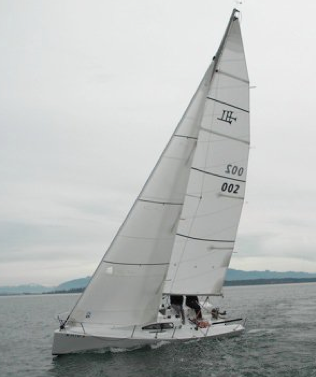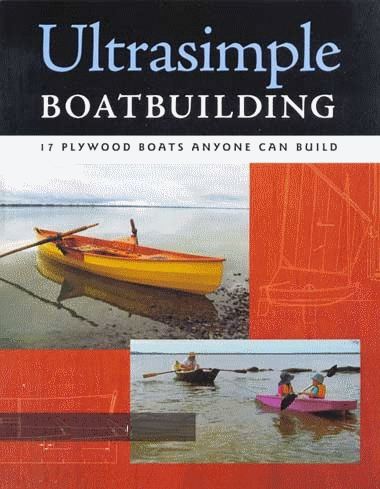
Not long ago I met Jim Lee at a community college in Oak Harbor, WA where I happened to be teaching a seminar on composite materials. Jim mentioned that he wanted to start a boat company in Anacortes and was searching for a design similar to the B25, which, coincidentally, I had designed back in 1987. The B25 had been a highly successful trailerable sailboat with a long string of victories at major events in the 1980s and 1990s.
Jim had sailed a B25 on San Francisco Bay and we agreed that it would be a great idea to produce an update of that design. So I made some preliminary drawings for a boat that would be a worthy successor to the B25 and it became the Left Coast Dart. The idea was to continue the theme of a fast, seaworthy boat with a lifting keel that could easily be trailered. It would have basic accommodations, including good sized berths, a porta-potty and a place for a single burner stove. It would have just enough comfort for a couple with perhaps a kid or two to spend a night or weekend aboard. I wanted the styling to be roughly the same as the B25 but modernized.
In the years since I drew the 25, there have been vast improvements in composite materials and processes as well as the design tools we use. In 1987 I drew all my boats by hand and had only rudimentary computational devices to optimize the hull design. Today I use powerful software to model the hull, rig and foils in the computer and generate the drawings in AutoCAD. So lets start with the hull design.
In the lines plan you can see the fineness of the bow sections and the slightly hollow waterlines. Notice that the bow is not quite plumb. I prefer that over a plumb bow purely for aesthetic reasons. Aft, I gave this hull a flat, clean run and firm bilges. I could have incorporated a hard chine here, but this boat will operate in both displacement mode and planing mode and chines add a bit of turbulence when the boat is traveling at hull speed. I think chines are something of a fad these days. You find them even on beefy Jeanneaus and Beneteaus that will likely never surf, let alone plane. Here are some numbers:
The keel is a vertical fin with a torpedo bulb. If youre a regular reader of this blog you know Im not a fan of this type of keel for cruising boats. For racers, it is the best solution from a performance perspective. At about 6 feet of draft, the Dart is deeper than the average boat of this size and nearly all of the lead ballast is in the bulb, making it a stiff boat. I designed a kelp cutter for the keel, which would be built into the leading edge. Youll want to order that option for sailing in southern California. The rudder is a deep, high aspect ratio foil with the leading edge tucked under the transom to provide balance. The result is a light helm and very easy steering. The numbers indicate a lightweight, high powered vessel, but not extreme. It will provide excellent light air performance and exhilarating downwind speed.
I originally designed the boat for a carbon fiber mast and retractable bow pole, but Jim was adamant that it be fitted with an aluminum rig. Aluminum is certainly less expensive but it costs the boat about 12-18 seconds/mile in performance. Jim was also fiercely opposed to the bow pole, preferring instead a conventional symmetrical kite. This also cuts into the boats performance and it didnt take long before he added a short bowsprit. My hope is that the next boat out of the mold will be fitted with a retractable pole and a carbon rig to take advantage of the boats true potential.
On deck, goal was to make the boat a comfortable and efficient sailing machine. The cockpit is long and wide with the mainsheet traveler mounted on the sole. Jib tracks are mounted well inboard for close sheeting angles. With the compact proportions of the cabin trunk, the companionway hatch lifts off instead of sliding forward. This caused Jim no end of tension, but its really the only way to make it work on a boat of this size and type.
Jim did some innovative things with the electrical system, such as molding the electrical wiring into the deck so there is almost no wiring visible in the boat. Along the way he invented the Simple Stereo which enables you to connect your IPod or MP3 directly into the amp and and rock the boat. Construction is is vacuum infused vinylester resin using biaxial e-glass over a lightweight Corecell foam core. This is standard practice these days and it is a vast improvement over the hand layup method we used back when we were building B25s. The Dart is longer, roomier and much faster.
When Jim started this project he was fairly new to boatbuilding. Its not easy to be a boatbuilder even in the best of times and the last few years have been anything but. So I give Jim a lot of credit for sticking with it and building exquisitely detailed pocket racers. For Jim, I think its more about building very nice boats than making a profit, and that is a refreshing departure from the thrown together boats we often see at the boat shows these days.
In its brief career the Dart has had some impressive wins:
First Overall, 2012 Lake Pontchartrain Racing
First in class, 2012 Whidbey Island Race Week
First in class, 2011 PITCH Regatta (Bellingham)
First in class, 2011 Windermere Regatta.
Check out Left Coast Yachts at http://www.eskimo.com/~leftcst/iWeb/Left_Coast/The_Dart.html
 |
| Dart with a mini-sprit punching upwind |
Jim had sailed a B25 on San Francisco Bay and we agreed that it would be a great idea to produce an update of that design. So I made some preliminary drawings for a boat that would be a worthy successor to the B25 and it became the Left Coast Dart. The idea was to continue the theme of a fast, seaworthy boat with a lifting keel that could easily be trailered. It would have basic accommodations, including good sized berths, a porta-potty and a place for a single burner stove. It would have just enough comfort for a couple with perhaps a kid or two to spend a night or weekend aboard. I wanted the styling to be roughly the same as the B25 but modernized.
 |
| Notice the dacron sails. Laminated sails would be lighter and faster. |
In the years since I drew the 25, there have been vast improvements in composite materials and processes as well as the design tools we use. In 1987 I drew all my boats by hand and had only rudimentary computational devices to optimize the hull design. Today I use powerful software to model the hull, rig and foils in the computer and generate the drawings in AutoCAD. So lets start with the hull design.
 |
| Lines Plan showing fine waterlines forward and powerful aft sections |
In the lines plan you can see the fineness of the bow sections and the slightly hollow waterlines. Notice that the bow is not quite plumb. I prefer that over a plumb bow purely for aesthetic reasons. Aft, I gave this hull a flat, clean run and firm bilges. I could have incorporated a hard chine here, but this boat will operate in both displacement mode and planing mode and chines add a bit of turbulence when the boat is traveling at hull speed. I think chines are something of a fad these days. You find them even on beefy Jeanneaus and Beneteaus that will likely never surf, let alone plane. Here are some numbers:
LOA -- 25’- 10”
LWL -- 22’- 10”
BMAX -- 8’- 4”
DRAFT -- 6’- 0” (Keel Down)
Draft -- 3’- 0” (Keel Up)
DISP -- 2,200 LB
BALLAST -- 850 LB
SA (100%) -- 338 SF
DISP/LENGTH -- 82.54
SA/DISP -- 31.97
I -- 31’- 6”
J -- 9’- 1”
P -- 31’- 3”
E -- 12’- 6”
The keel is a vertical fin with a torpedo bulb. If youre a regular reader of this blog you know Im not a fan of this type of keel for cruising boats. For racers, it is the best solution from a performance perspective. At about 6 feet of draft, the Dart is deeper than the average boat of this size and nearly all of the lead ballast is in the bulb, making it a stiff boat. I designed a kelp cutter for the keel, which would be built into the leading edge. Youll want to order that option for sailing in southern California. The rudder is a deep, high aspect ratio foil with the leading edge tucked under the transom to provide balance. The result is a light helm and very easy steering. The numbers indicate a lightweight, high powered vessel, but not extreme. It will provide excellent light air performance and exhilarating downwind speed.
 |
| Superb craftsmanship on the keel plug. They used this to create the keel mold. |
I originally designed the boat for a carbon fiber mast and retractable bow pole, but Jim was adamant that it be fitted with an aluminum rig. Aluminum is certainly less expensive but it costs the boat about 12-18 seconds/mile in performance. Jim was also fiercely opposed to the bow pole, preferring instead a conventional symmetrical kite. This also cuts into the boats performance and it didnt take long before he added a short bowsprit. My hope is that the next boat out of the mold will be fitted with a retractable pole and a carbon rig to take advantage of the boats true potential.
 |
| Dart, circa 2010. Non-overlapping jibs and moderate proportions for the spinnaker |
 |
| B25 circa 1987 |
 |
| 1991 B25 Listed on Yachtworld for $21,000 |
 |
| Simple, efficient deck plan |
On deck, goal was to make the boat a comfortable and efficient sailing machine. The cockpit is long and wide with the mainsheet traveler mounted on the sole. Jib tracks are mounted well inboard for close sheeting angles. With the compact proportions of the cabin trunk, the companionway hatch lifts off instead of sliding forward. This caused Jim no end of tension, but its really the only way to make it work on a boat of this size and type.
 |
| The original design had a split bow pulpit. Jim preferred the type shown here, but you can order the split version. |
Jim did some innovative things with the electrical system, such as molding the electrical wiring into the deck so there is almost no wiring visible in the boat. Along the way he invented the Simple Stereo which enables you to connect your IPod or MP3 directly into the amp and and rock the boat. Construction is is vacuum infused vinylester resin using biaxial e-glass over a lightweight Corecell foam core. This is standard practice these days and it is a vast improvement over the hand layup method we used back when we were building B25s. The Dart is longer, roomier and much faster.
 |
| Simple, lightweight accommodations. Most who seriously race this boat would dispense with the V-berth. |
 |
| Lightweight internal structure with just enough wood to keep it interesting. |
 |
| Hull #1 sitting outside Jims shop in Anacortes |
In its brief career the Dart has had some impressive wins:
First Overall, 2012 Lake Pontchartrain Racing
First in class, 2012 Whidbey Island Race Week
First in class, 2011 PITCH Regatta (Bellingham)
First in class, 2011 Windermere Regatta.
Check out Left Coast Yachts at http://www.eskimo.com/~leftcst/iWeb/Left_Coast/The_Dart.html


0 komentar:
Posting Komentar